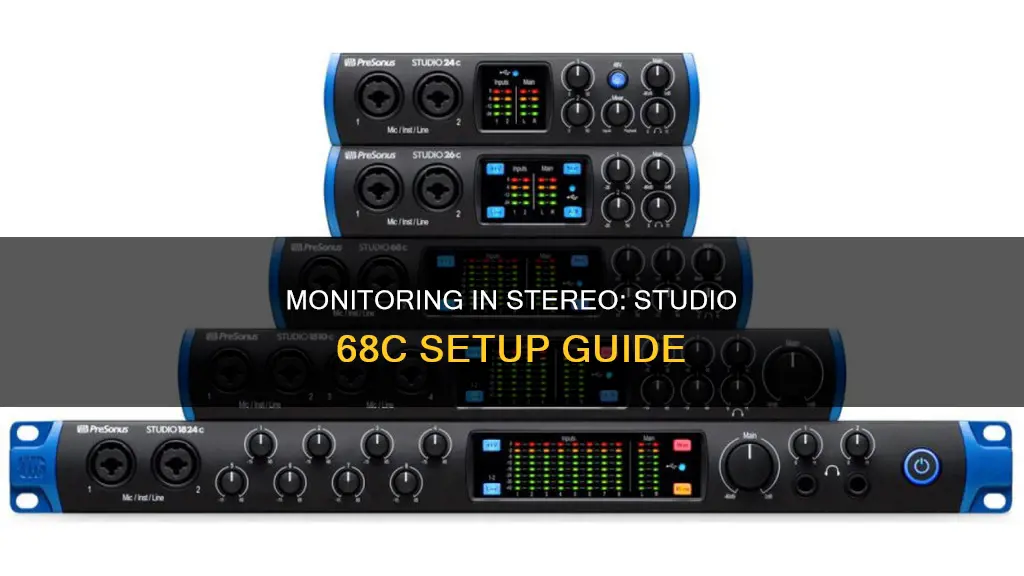
The PreSonus Studio 68c is a versatile, ultra-high-def USB-C audio interface with a powerful headphone amp and A/B switching that allows you to listen to either of two mixes, making it ideal for live performances. While it is a perfect companion for any recording software, it is not capable of monitoring stereo in real time.
| Characteristics | Values |
|---|---|
| Price | $229.99 |
| Outputs | 2 stereo outputs, 2 DC coupled, balanced, 1/4" TRS line outputs, 2 DC coupled, balanced, 1/4" TRS main outputs |
| Inputs | 2 mic/instrument/line inputs, 2 mic/line inputs with XMAX-L mic preamps, 2 high-headroom instrument inputs, 4 balanced TRS line inputs |
| Connectivity | USB-C compatible, USB-C to USB-C and USB-C to USB-A cables included |
| Preamps | 4 XMAX Class A mic preamps |
| Converters | Studio-grade, 24-bit/192 kHz recording and playback (limited to 4 tracks at 192kHz) |
| Software | Studio One Artist, Studio Magic plug-in suite, Ableton Live Lite, Studio One Pro+ |
| Metering | Professional input and output ladder-style LED level meters |
| Mix | Cue Mix A/B function |
| MIDI | MIDI I/O |
| Bit Depth | 24-bit |
| Sample Rates | 44.1, 48, 88.2, 96, 176.4, or 192 kHz |
| Headphone Outputs | High-power, 150 mW/Channel (56Ω load) |
What You'll Learn

Using the Cue Mix A/B function to toggle between two mixes
The Presonus Studio 68C audio interface is a powerful, portable, and compact recording suite. It is ideal for musicians, DJs, and producers, and can be used for a range of applications, from studio-grade recordings to podcasting and DJing.
The Cue Mix A/B function is a key feature of the Studio 68C. This function allows you to toggle between two mixes while monitoring through headphones. This can be extremely useful in various situations. For example, if you are a musician, you can use the Cue Mix A/B function to audition mixes in real time. This means you can easily switch between two different mixes of your song to compare them and decide which one works better.
The Cue Mix A/B function is also beneficial for DJs. It allows you to listen to two different mixes simultaneously, which can be handy when you want to smoothly transition between songs during a live performance. Additionally, the Cue Mix A/B function can be used to listen in on a performer's monitor mix. This is useful if you are working with other musicians or performers and need to hear what they are hearing in their monitor mix.
The Studio 68C's Cue Mix A/B function provides great versatility and can enhance your workflow, whether you are creating music, performing live, or collaborating with other artists. It allows you to easily switch between different mixes and monitor them through your headphones, giving you more control over your audio experience.
The Studio 68C, with its Cue Mix A/B functionality, is a powerful tool that can elevate your music production, performance, and collaboration capabilities. Its compact and portable design, combined with its versatile features, makes it a great choice for professionals seeking convenience and high-quality audio experiences.
Finding Monitor Details on Windows 10: A Quick Guide
You may want to see also

Connecting a second PC for stereo monitoring
Now, let's discuss the process:
Step 1: Configure the Studio 68c Interface
The Studio 68c interface has four XMAX analog mic preamps and two stereo outputs, providing flexible output options. To set up stereo monitoring, you need to configure the interface's settings. This can be done through the Universal Control (UC) driver installer and control app. In UC, you can adjust various settings, including input and output configurations.
Step 2: Set Up the First PC
Connect the Studio 68c interface to your first PC using the provided USB cables. Ensure that the PC recognizes the interface and that the necessary drivers are installed. You can refer to the Studio 68c manual for detailed instructions on connecting and setting up the interface with your computer.
Step 3: Connect the Second PC
Now, connect the second PC to the Studio 68c interface using the appropriate cables. You can use the stereo output from the second PC and connect it to the interface's channels. However, as mentioned in the PreSonus forums, the interface may handle these inputs as separate mono signals by default.
Step 4: Configure Stereo Monitoring
To achieve stereo monitoring, you may need to adjust the settings in your audio software. In PreSonus Studio One, for example, you can set the input and output channels as stereo instead of mono. This can be done in the I/O settings within Studio One. Additionally, you can use the direct monitoring feature on the Studio 68c interface, which allows you to monitor the input signal directly from the interface before it goes to your audio software.
By following these steps and adjusting the settings on both the interface and your audio software, you should be able to achieve stereo monitoring with a second PC connected to your Studio 68c interface.
Best Places to Buy Power Cords for Monitors
You may want to see also

Using Studio One Artist to monitor input
Studio One Artist is a music production software that comes bundled with PreSonus audio interfaces. It is designed to work seamlessly with PreSonus interfaces, making setup quick and easy.
To use Studio One Artist to monitor input, follow these steps:
- Enable Your Audio Driver: Studio One Artist is designed with PreSonus interfaces in mind. When you launch the software, you will be taken to the Start page. Verify that the PreSonus driver has been detected.
- Configure Your External MIDI Devices: Connect the MIDI Out of your external MIDI controller to the MIDI In of your PreSonus interface. In Studio One Artist, go to "Configure External Devices" and click "Add". Choose your device from the list or set it as a "New Keyboard" if it is not listed. Specify the MIDI channels to use and engage Split Channels if you want to create separate Instrument Track inputs for each MIDI channel.
- Configure Your Audio I/O: Go to "File > Options > Audio Setup" (on PC) or "Studio One > Preferences > Audio Setup" (on Mac). Here, you can select your audio device and configure its settings. Set the Device Block Size to fit your needs, keeping in mind that lower settings minimize latency.
- Create a New Song: Launch the Song window and go to "File > Options > Audio Setup" (PC) or "Studio One > Preferences > Audio Setup" (Mac). Create a mono input for each of the inputs on your PreSonus interface. If you plan on recording in stereo, create a stereo bus and assign it to the appropriate set of inputs.
- Assign Inputs and Enable Monitoring: Create an audio track and assign it to one of the inputs. Connect a microphone or instrument to the corresponding channel on your PreSonus interface. Enable the record and monitor buttons on your track in Studio One Artist. Adjust the gain knob on your interface while speaking/singing into the microphone or playing your instrument.
- Convert MIDI Data to Audio Waveform (if applicable): When you are ready to mix your song, convert any recorded MIDI data to an audio waveform by recording a new audio track.
By following these steps, you can effectively use Studio One Artist to monitor input and have greater control over your recording and mixing process.
Choosing the Right Monitor Size for CAD Work
You may want to see also

Setting up a direct monitoring switch
The Studio 68c features a Direct Monitoring switch that sums the analog signal with the playback streams, giving you an equal mix of the two. To set up your direct monitoring switch, follow these steps:
- Set a good recording level for your input.
- Adjust the output level of the playback from your DAW by raising or lowering the Main output level of your DAW to taste using the main fader in your DAW console.
- Ensure that software monitoring is disabled in your DAW. In Studio One, for example, simply click on the monitor button on the track.
- Now, when you use the Direct Monitoring switch on your Studio 68c, you will hear a blend of the analog input signal and the playback stream from your computer, allowing you to fine-tune your monitor mix.
Remember, direct monitoring is especially useful when you need to hear effects, compression, and equalization in your headphones while recording. For example, if reverb on a vocal is going to be part of the final mix, it’s nearly impossible to record the vocal without hearing the reverb because phrasing and timing are significantly different.
Monitoring Folder Sizes: Strategies for Effective Data Management
You may want to see also

Using a complex DSP mixer
The Studio 192 and Studio 192 Mobile are examples of audio interfaces that provide powerful onboard digital signal processing (DSP) capabilities, allowing for complex DSP mixer functionality. These devices are equipped with a robust onboard DSP that can run 16 instances of the Studio One Fat Channel plugin, as well as reverb and delay effects. This enables users to create professional-sounding monitor mixes with effects, compression, and equalization.
The complex DSP mixer in the Studio 192 series offers similar features to an inline digital mixer, providing flexibility in routing and mixing audio signals. It is important to note that the Studio 68c does not have the same DSP capabilities as the Studio 192 series. However, it does include a Direct Monitoring Switch, which sums the analog signal with the playback streams, allowing for an equal mix of the two.
To create a monitor mix using the Studio 192 or 192 Mobile (or any Studio-series interface), follow these steps:
- Gain Staging: Set the input level of your source using the metering in your DAW, not UC Surface.
- Select Your Mix: Choose the mix you want to start with, for example, Mix 1/2.
- Set Your Channel Level: Adjust the fader until you achieve a suitable level for your mix.
- Set Your Pan: Modify the panning of your channel to make it more prominent in the mix by allowing it to stand out among other channels. Avoid setting the pan position to the centre for every channel to prevent comb filtering and distortion.
- Dial in Your Dynamics and EQ: Select your channel and fine-tune the gate, compression, and EQ to your desired settings.
- Decide if You Want to Print: If you are satisfied with the sound, engage the Post Send button to record the signal exactly as you hear it, including any gate, compression, and EQ processing.
- Add Some Reverb: Click on FX A Mix and adjust the fader to control the amount of reverb added to your mix.
By following these steps, you can take advantage of the complex DSP mixer capabilities of the Studio 192 series interfaces to create sophisticated monitor mixes with effects and processing.
Disabling Performance Monitor: A Step-by-Step Guide
You may want to see also
Frequently asked questions
The Studio 68c is a versatile, ultra-high-def USB-C audio interface. It comes with a Studio One Artist license included, so it's an audio production powerhouse right out of the box. The Studio 68c is compatible with macOS and Windows recording software.
The Studio 68c delivers ultra-high-def sound, with four PreSonus XMAX analog mic preamps, professional metering, and monitoring features. The XMAX mic preamps deliver high headroom, deep lows, smooth highs, and a rich overall sound.
The Studio 68c has two mic/instrument/line inputs and two mic/line inputs with XMAX-L mic preamps. It also features two balanced 1/4" TRS main outputs and two balanced 1/4" TRS line outputs for monitor mixing.
The Studio 68c includes Studio One Artist, Studio Magic Plug-in Suite, and Ableton Live Lite.
Some users have reported issues with latency and software compatibility. However, these issues can often be resolved by adjusting settings or using different software.







